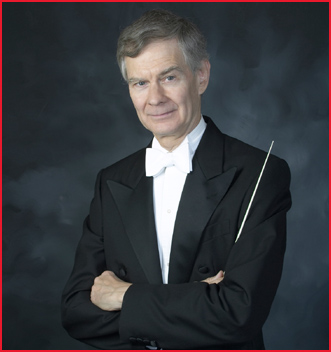New England Philharmonic hits the dance floor with Terpsichorean program

Richard Pittman led the New England Philharmonic in a wide-ranging program with two world premieres Saturday night at the Tsai Performance Center.
Few amateur orchestras offer performances of new music through commissions, calls for scores, and a composer-in-residence. But the New England Philharmonic is unique among volunteer ensembles as it continues to present concerts that offer a bracing mix of the old and new, a formula that last season led to the orchestra’s ninth ASCAP award for adventurous programming.
The trend continued Saturday night at the Tsai Performance Center, where Richard Pittman led the New England Philharmonic in a characteristically creative and wide-ranging program.
Two works received top billing: the Fifth Symphony of David Rakowski, entitled Dance Episodes, and Bernard Hoffer’s Ligeti Split, both of which received world premieres.
Rakowski, who has been composer-in-residence with the NEP since 2011, composed his new symphony on a commission from the orchestra for a short work based on dance-like themes. The resulting twenty-three-minute symphony is a tautly constructed and energetic affair.
Dance Episodes is chock full of catchy ideas. Whiffs of pizzicatos and twisting wind motives collide into a dense swirl in the first movement, aptly titled “Zephyrs.” The second, “Masks,” is based upon a slithery theme, played by sliding trombones, and bustling sixteenth-note figures that scatter throughout the full ensemble. The third and shortest movement, “Tristesse,” evolves from a serpentine violin solo, played with honeyed tone by concertmaster Danielle Maddon. A snappy rock riff drives the momentum of the final movement, “Motive Perpetuo,” in a style similar to John Adams’ Lollapalooza.
At times, Rakowski’s ideas seem to burn themselves out prematurely, the movements stopping short of full realization. Nevertheless, Pittman led the orchestra in a spirited reading that gave the work bold advocacy.
Hoffer’s Ligeti Split is a play on György Ligeti’s astringent musical style. But where the textures of the late composer’s music tend to glide inconspicuously in and out of one another, Hoffer’s are clear and well defined but full of surprising twists and turns that make for a bit of fun listening.
It is the jazz elements that make Ligeti Split such a joy to hear. Walking basses and the accompanying swing of a ride cymbal slowly break up the airy chords that open the work. A driving groove comes to dominate the seemingly desolate soundscape as gnarly riffs pass between piano, vibraphone, muted trumpet, oboe and strings. Thick orchestral textures and chord bursts return to bring the piece to a fiery, toe-tapping conclusion. Pittman led a nimble reading, and the orchestra played with polish and live-wire intensity.
The concert opened with Ligeti’s Ramifications (1969), a mesmerizing study in prickly musical textures for twelve solo strings. The piece is hypnotic. Subtle waving motives in the violin and violas, tuned a quarter tone apart, grate against one another to create a harmonic veneer that shimmers like light on water. The lines then begin to move independently of one another, swelling to a rabble before breaking into streams of glassy harmonics. The NEP played well, though the music’s thornier textures and aggressive passages could have used a little more bite to mine the work’s shadows and light.
That was remedied with the two remaining works of the evening, music that was used for and inspired by dance.
It’s well known that Stravinsky’s Capriccio for Piano and Orchestra (1929) has had a long association with ballet, the most famous of which is George Balanchine’s Jewels of 1967. But with its sparkling lines and bright energy, it’s a wonder that this gem from Stravinsky’s neoclassical period doesn’t get played more often as a concert work. The three movements of Capriccio thrust with punchy rhythms and its textures are sprinkled with pointillistic writing. Acrobatic lines dart every which way as the music never seems to quiet down.
Pianist Randall Hodgkinson played with crispness and sure-footed rhythmic bounce. Pittman led an energetic, if stately, reading of the outer movements while milking the rhapsodic elements from the second’s marked Andante. The orchestra didn’t always answer with the same vitality rendered by the pianist, but the musicians kept up the momentum, supplying sturdy accompaniment when called upon.
Save for Bolero, there may be no more dance-inflected music in Ravel’s oeuvre than La Valse. Composed between 1919 and 1920, the piece is a tour de force of orchestral color.
Saturday’s performance, though, was a little skittish. The low murmurs and hints of waltz melody that pepper the opening of work lacked definition, the lilting dance music taking some time to get off the ground. But when it did, the orchestra sounded at its finest.
Saturday’s ambitious and challenging concert was, on the whole, a worthy effort. With more refined playing all around, the New England Philharmonic has made great leaps forward since last season.
Richard Pittman will lead the New England Philharmonic in music by Honegger, Villa-Lobos, Kapilow, and Gandolfi, featuring baritone David Kravitz 3 p.m. December 14 at the Tsai Performance Center. nephilharmonic.org.
Posted in Performances





Posted Oct 26, 2014 at 8:03 pm by Nick van Boston
🙂